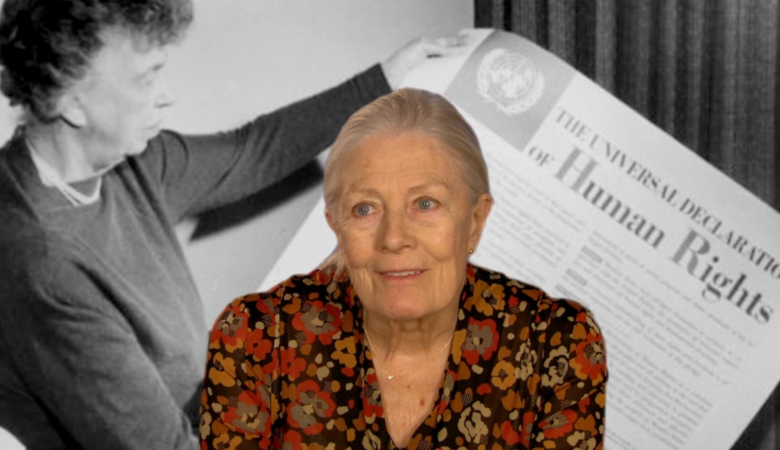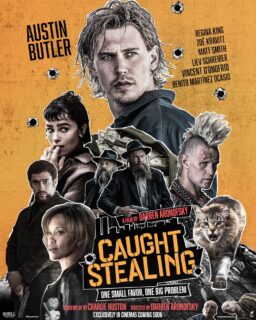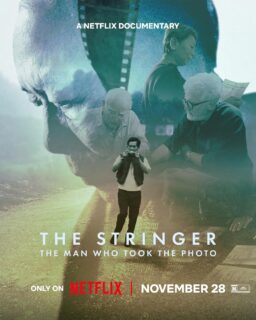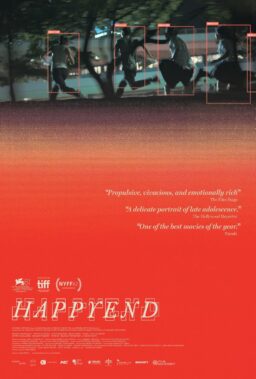Over a screen career spanning more than a half-century, Vanessa Redgrave has become one of the most celebrated actresses in the world. She’s achieved this with roles in such films as “Morgan: A Suitable Case for Treatment” (1966), for which she received the first of her six Oscar nominations, “Blow-Up” (1966), “Camelot” (1967), “Isadora” (1968), “The Devils” (1971), “Julia” (1977), for which she won the Supporting Actress Oscar, “Agatha” (1979), “The Bostonians” (1984), “Howards End” (1992), “Mission: Impossible” (1996), “Atonement” (2007) and “Foxcatcher” (2014), to name just a few.
With her new film, “Sea Sorrow,” which screens at the Chicago International Film Festival tonight with her in attendance, Redgrave takes on a role that she has never tackled before—that of a director. The documentary, which was produced by her son, Carlo Nero, takes a look at the current refugee crisis that mixes together interviews with refugees, aid workers, politicians and activists with readings from Shakespeare’s “The Tempest” (the source of the film’s title) and an actual 1938 letter from a British woman hoping to take in a couple of refugees on the eve of World War II and Redgrave’s personal reminiscences of being a refugee herself when she and other British children were sent away from the cities in advance of the Nazi bombings.
In advance at her arrival at the festival, where “Sea Sorrow” will be presented as part of a tribute to her career that will also include screenings of the still-ahead-of-its-time “Blow-Up,” Redgrave got on the phone to discuss both films, her move behind the camera and how Jason Blum, the guy behind the “Purge” movies himself, was responsible for what she calls “the best day of my life in film.”
Was directing something that you have wanted to do before or was it inspired by this specific project?
I have produced films but I have never directed before. I have acted my entire life but I wanted to make this film as a director and I couldn’t have made it without Carlo Nero because I don’t have the wherewithal, not having been a director before in my life. I had the instincts for what I wanted to do but I didn’t know how to do it.
It mixes together a number of different elements, including interviews with those involved with the current crisis, a personal examination of your own time as a refugee and even a couple of staged readings featuring Ralph Fiennes performing a piece of Shakespeare’s “The Tempest” and Emma Thompson reading the Sylvia Parkhurst letter. How did you decide upon this particular approach for the film?
I think I knew for a long time that I wanted Prospero’s story to his daughter, Miranda, about when they were forcibly turned into refugees after being a prince and princess in Milan—the highest position that there was—by a political act and driven out of the city and onto a boat.
[With the personal story] Carlo Nero kind of insisted, actually, that I should explore that and he convinced me that it was important, not only because it, in a way, coincides with the interview with Alf Dubs. We were both little children—he was in Czechoslovakia when the Nazis came into Prague and I was in England, not knowing anything about Czechoslovakia at all but, like all the other children in London, we had to evacuate from the cities because of the bombings. I was worried because I just felt that it would be a mistake to put me in the position of a central position in the film but he convinced me and I am thrilled that he did convince me because it is really important in that it could help open a few doors for people who are watching it who might see it and feel “That could be me.”
In doing this film, you were obviously not approaching the subject as a complete novice. Nevertheless, in working on this project, were there aspects about the current refugee crisis that surprised or shocked even you?
I didn’t expect that our British government would be so hopelessly terrible. In the United States, a report was just published by the Women’s Refugee Commission, which is based in New York and is a sub-commission of the International Rescue Committee, that shows the huge numbers of refugee women and children who are incarcerated in the United States—not having done any crime of any level whatsoever. That have only come to seek asylum and they have the right to seek asylum. Therefore, the authorities in the United States are breaking the law by keeping them in prison and for what? For seeking protection. It is terrifying.
How did you go about selecting the people that you interview in the film?
Some of the interviews were done at the march that took place in September, 2016. I knew I wanted to talk to the lady that is the head of Amnesty International in the United Kingdom, Kate Allen. I knew I wanted to interview my niece, Gemma Redgrave, who was on the march. I knew I wanted to interview Alf Dubs—he was integral to the film getting made. Also Martin Sherman, who I went to Greece with.
Where did the idea of bringing Ralph Fiennes and Emma Thompson in come about?
Because I wanted “The Tempest” and this extraordinary small scene of Prospero, who appears in the play as this magician, telling the story of how he was deported from his kingdom when his daughter was just three years old. I don’t know why—I can’t really put it into words but it really seems to hit spectators in an unexpected way. With Emma Thompson, I knew that she would be wonderful reading the newspaper. It was a real newspaper and a real lady and a real letter that she wrote in November of 1938, the year after I was born. This was to highlight in a very personal way, as Emma reads it, that it was a typical letter from a typical British person who wanted to save refugees—these two young girls, one a young Jewish music student who had escaped to the United Kingdom and the other who was being expelled by the British home office and had nowhere to go. It was just an individual and unusual way of getting through what was going on and how somebody physically felt about people dying and who never got interviewed anywhere.
What was the experience of directing like for you?
I’m not sure if I can really put it into words. It was frustrating because I don’t know the technology, so thank goodness for Carlo and our editor, Folasade Oyeleye, because they could explain to me, through my frustration, what had to happen before I could accomplish what I wanted to have happen. I come from the old days with cutting real film. It is a different world and the young people now are just pressing buttons. It is a completely different world from when you would just splice a piece of film. I just got frustrated because I wanted it to happen just like that and it can’t happen like that. The point, of course, is that being involved with film, I had really good advice and encouragement and criticism from Carlo and what I wanted to happen did come through, at least to me.
I think that this film will be a classic in that it won’t just come and go with the times. The horror, of course, is that these wars are going on and thanks to the leading politicians and governments of the world, these wars are going to continue. One thing that we must do and can do is to cherish and provide protection to the young people and especially the women and children. In Britain, we need to get them the legal right to enter Britain, which many of these refugees have, but they are having to go to court and support court actions to get the government to do what it ought to do legally. It is a strange situation.

The festival is also going to be honoring your visit with a couple of screenings of “Blow-Up,” the ground-breaking 1966 film that you did with Michelangelo Antonioni that continues to startle and perplex viewers more than a half-decade after it was first released. What is it about the film that you think gives it its power to resonate with audiences after more than a half-century?
I think it is in part because there is mystery in the narrative and there are all these layers in the narrative. I think that is part of why that is. Of course, it is also an Antonioni film and his films are always infused with a compulsion to watch them, I think.
When you first read the screenplay for the film, what was your first reaction to it?
I don’t remember. I do know that I was thrilled to pieces to be asked to work with Antonioni. That is all I could think of and I was prepared to do anything. He said he wanted to dye my hair black and I was a little bit disappointed because I had hoped to look more like Monica Vitti, who was his love at the time and a very lovely Italian actress. I was so thrilled to work with him that the script could have said anything and I would have still be thrilled.
Did you ever have the sense of just how radical and groundbreaking of a work it would prove to be during the actual filming of it?
I don’t know if I would have used the word “radical” but I knew that it would be way out of the ordinary because it didn’t, like so many Anglo-American films do, rely on the obvious.
Are there any titles in your filmography that you are particularly proud of and which you would like to steer people towards seeing?
There are two. First of all, there is “The Fever,” which we did—Carlo directed—for HBO Films, which was made in 2007. I considered that at the time and still consider that to be … I don’t want to use the term and make it sound too high-flying, but I consider it to be the statement of my life and my work. I just feel as if that is the most important thing that I could have ever done, filmwise. The other one was “Playing for Time” by Arthur Miller, which was for CBS and was a three-hour movie that told the story of the women’s orchestra at Auschwitz. “The Fever” was written by Wallace Shawn and was based on his play and it was a truly remarkable film. I was thrilled, absolutely thrilled, when HBO said that they wanted to do it. They were fascinated for a while but even when we got Angelina Jolie to appear in the film in a crucial scene, even then we had trouble getting the green light. What changed it was that HBO needed a producer who they felt sure could see the film through in time and et cetera, et cetera. We went to Jason Blum [producer of “The Purge“], who had just done a piece of work for HBO, and he said okay and we got the green light. That was the best day of my life in film—the day we got the green light for “The Fever.”
“Sea Sorrow” will be screening as part of the Chicago International Film Festival at the AMC River East 21 on October 16 and “Blow-Up” will show on October 16 and 17 with Vanessa Redgrave currently scheduled to appear at all of them. Tickets can be purchased in person at the theater, online at chicagofilmfestival.com and ticketmaster.com/chicagofilmfestival or over the phone at (312)332-FILM. For further information on titles, running times, ticket prices and availability and program changes, go to the festival site at chicagofilmfestival.com. The Chicago International Film Festival runs from October 12-26.












